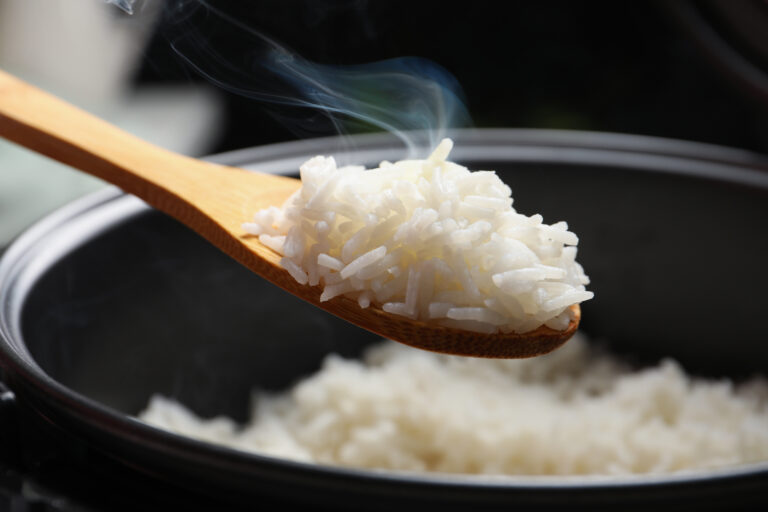A strong focus has recently been put on heavy metals in baby foods, particularly that of arsenic in infant rice cereals, by the FDA, states, and baby food companies. But, despite the fact that rice has been recognized as a leading dietary source of inorganic arsenic, that focus has not extended to other rice products for compromised individuals (toddlers and older children, pregnant women, etc.) or the general population. To bring the issue to light, a new study What’s in your family’s rice? has been published by Healthy Babies Bright Futures extrapolating FDA’s infant action levels to a general population product and providing practical recommendations on safer rice choices.
While finding the report to be science-based, we note that, in utilizing infant exposure and health risk from heavy metals in rice, the researchers assume a “direct extrapolation” to the adult general population who are generally much less at risk from arsenic and other heavy metals than children. By doing so, they fail to consider general, and sub-population, adult intakes of rice products as well as the relative risk of the heavy metals from other foods. Additionally, arsenic is a naturally occurring element and, as such, its presence in rice is often driven by factors that are beyond our control. However, the levels of arsenic in rice will vary depending on where it is grown, and this report helps to illustrate that point as food companies look for ways to minimize arsenic in rice that will be used for high-risk populations such as infants.
For the study, the researchers, along with volunteers from other non-profit organizations, purchased 145 rice and 66 grain varieties from 53 stores in 20 metro areas across the US and online. The grains were tested for four heavy metals — arsenic, lead, cadmium, and mercury, along with inorganic arsenic in the rice. The findings:
In looking at rice samples, from both US-grown and imported:
- In all but seven of the samples, arsenic was found at the highest rate of all the heavy metals.
- In those seven, cadmium was the highest.
- When looking at the total heavy metals in rice, on average, arsenic accounted for 79% of the total heavy metal content; cadmium made up 17%; and mercury and lead made up 2% each.
- Contaminant levels varied by rice type and region.
In the alternative grains, rice averaged three times more heavy metals than alternative grains (108 ppb versus 33 ppb), and contained an average of 28 times more arsenic, although the grains had more cadmium, 1.5 times more than rice.
The report does, however, provide some regulatory recommendations for FDA and/or states, along with practical options for consumers to reduce the risk from rice. These recommendations are clearly not without their challenges, but should be kept in mind by the food industry as potential outcomes of this report:
Regulatory Actions:
- Set limits on arsenic and cadmium in rice. FDA could establish action levels for the heavy metals, with rice that exceeds the current level for infant rice cereal (100 ppb inorganic arsenic), or contains cadmium at levels well above typical amounts, to not be allowed for sale.
- Permit the packaging claim: “Meets FDA health guidelines for infant rice cereal.” To qualify, companies would test representative samples of each lot, meet FDA’s 100 ppb action level for arsenic in infant rice cereal, and post the results online.
- Require warning labels on rice with high arsenic levels. With “high levels” not defined, we would assume it would be anything over the FDA health guidelines for infant rice cereal as was the focus of the recommended package claim above.
- Require testing and public posting of results. With California and Maryland already requiring companies to test baby foods and publish results, other states could build on this model, so that all rice sold in the U.S. would undergo routine testing, with publicly accessible results.
- Issue clear guidance on best practices. To help industry adopt proven strategies that minimize arsenic and cadmium uptake in rice, FDA could issue guidance that is regularly updated to reflect the latest research, drive improvement, and incrementally lower arsenic and cadmium limits.
Consumer Actions:
- Cook rice in excess water, similar to the pasta method. Using six to ten cups of water per cup of rice and discarding excess water after cooking, can remove up to 60% of inorganic arsenic. Pre-soaking the rice for as little as 30 minutes can further reduce arsenic levels. Because this can also wash away the vitamins and iron that are added back to white rice after milling, meals should include nutrient-dense sides (e.g., beans, lentils, leafy greens, fruit, eggs).
- Use rice alternatives. Alternatives (e.g., quinoa, barley, couscous, farro) can be easily swapped for rice in meals and contain much lower total heavy metal levels.
- Choose rice with less contamination. Different rice types contain different heavy metal levels:
- Lower in total heavy metals: California rice – Calrose, Sushi, Jasmine, White; Jasmine rice (Thailand); Basmati rice (India).
- Lower in arsenic and cadmium: Brown rice grown in California vs. other brown rice.
- Higher in total heavy metals: White rice grown in the Southeast U.S. or USA; Brown rice; Arborio rice (risotto) from Italy.
- Higher in more toxic arsenic types and packaging chemicals: Precooked rice – Instant (5-minute), Parboiled (10-minute), and Ready-to-Heat.
This study is one to be aware of in terms of how it may be leveraged and is the reason why we focused on it this week. Rice is a staple in the meals of many families and cultures, yet heavy metal levels are generally considered only for infant foods. With the current HHS focus on chemical and heavy metal reduction, it’s likely only a matter of time before regulatory action is taken. Whether that be a focus on rice, another particular food or population, or a general industry-wide mandate is unknown. But, as we’ve stated since late 2024, there will be change so it’s wise to be prepared.
All written content in TAG articles, newsletters, and webpages is developed and written by TAG experts, not AI. We focus on the realities and the science to bring you the most current, exacting information possible.





